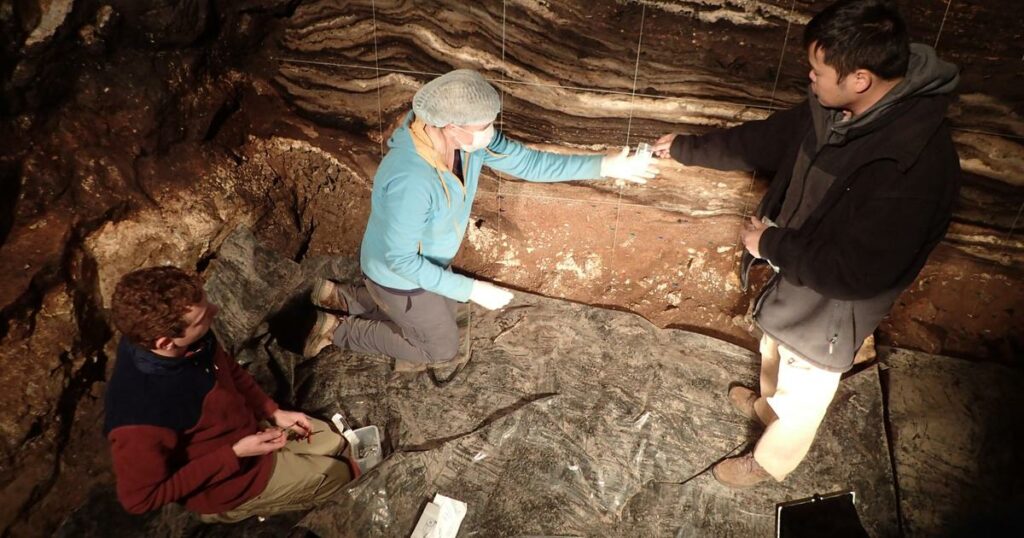A child’s tooth at least 130,000 years old discovered in a cave in Laos testifies to the presence of Denisova’s men in the tropical climate of Southeast Asia, lifting part of the veil on the mystery of this extinct species , according to a study.
Read alsoNotre-Dame de Paris: extraordinary archaeological discoveries on the sidelines of the construction site
Very little is known about the Denisovans, an archaic human cousin of Neanderthals, who were first identified in 2010 in a cave in Siberia. From a simple piece of phalanx, paleontologists were able to sequence a complete genome. They then found, in 2019, a mandible with large teeth on the Tibetan plateau, proving that the species had also lived in this part of China.
SEE ALSO – ‘It’s an extraordinary discovery’: Neanderthal fossils found in a cave in Italy
Interbreeding with Homo sapiens
Apart from these rare fossils, Denisova’s man had left no trace of his passage… Except in the genes since before disappearing, this so-called archaic species interbred with Homo sapiens, bequeathing a part of its DNA to present-day populations in Southeast Asia and Oceania: Negritos from the Philippines, Papuans from New Guinea and Aborigines from Australia hold a large proportion of the Denisovan genome – up to 5%.
Geneticists have deduced that « the modern ancestors of these populations had “hybridized” with Denisovans in Southeast Asia“, explains to AFP the paleoanthropologist Clément Zanolli, co-author of the study published Tuesday in Nature Communications. But it lacked thephysical evidenceof their presence in this part of the Asian continent, far from the cold mountains of Siberia or Tibet, adds this CNRS researcher. Until a team of scientists set out to excavate the Cobra Cave in northeastern Laos.
“Typically human” morphology
The cavity, located on a massif, was discovered in 2018 by speleologists near the site of Tam Pa Ling, known to have already delivered the remains of very ancient humans. The sediments preserved in the walls of the cave contained bone fragments of animals, as well as a molar. The tooth immediately presented a morphologytypically human“says Clément Zanolli. It must have belonged to a child between 3 and 8 years old because it was still growing in the jaw, the study said.
But from what period, what species? The tooth was too old for carbon-14 dating, and its DNA poorly preserved due to the hot and humid climate, underlines paleoanthropologist Fabrice Demeter, co-author. The researchers therefore circumvented the obstacle by dating the sediments containing the tooth and the remains of fauna, then the upper layer, to obtain a range of 160,000 to 130,000 years.
Read alsoPreventive archaeology: 20 years of discoveries
little girl molar
They then studied the inside of the tooth – temporarily exported to Denmark – using different methods such as X-ray microtomography and paleoproteomics (protein analysis). « The proteins allowed us to identify the sex, female, and to affirm its membership in the genus Homo“, explains Fabrice Demeter, researcher at the University of Copenhagen affiliated with the National Museum of Natural History in Paris.
And, surprisingly, the internal structure of the tooth turned out to be close to that of the molars of Denisova’s specimen from Tibet. « I was really expecting a Homo erectus!», recalls the paleoanthropologist. But no doubt, the molar was easily distinguishable from this ancient species, as well as other extinct groups endemic to the Philippines and Indonesia, Homo floresiensis and Homo luzonensis.
« Versatility » that dismisses the Neanderthal trail
And of course modern man. The only problem: it had common characteristics with the Neanderthals, genetically close to the Denisovans – the two species would have diverged around 350,000 years ago.
« But we leaned towards Denisova because we never found the trace of the passage of Neanderthal also in the East“, specifies Clément Zanolli. The Denisovans have therefore indeed occupied this part of Asia, a sign of adaptation to a wide range of environments, from cold altitudes to tropical climates, the study concludes. A « versatility« that their Neanderthal cousins did not seem to possess, more « specialized» on the cold regions of the West, explains Fabrice Demeter.
Read alsoDominique Garcia (Inrap): “Archeology has gained scientific maturity”
It was in the tropics that the later Denisovans might have encountered and hybridized with local modern human groups of the Pleistocene epoch, who transmitted their genetic heritage to present-day Southeast Asian populations.
SEE ALSO – Homo sapiens would have arrived in Europe much earlier than we imagined
.

